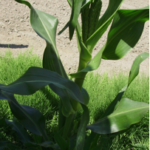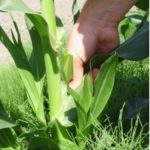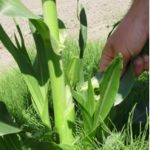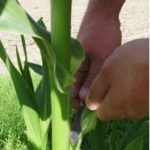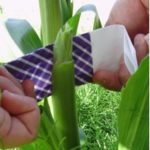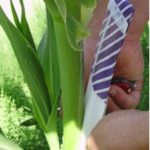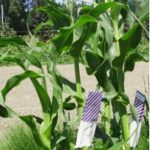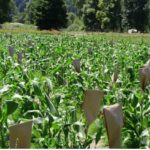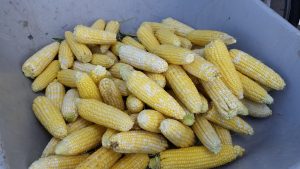
As August approaches, the next phase of the organic sweet corn project begins. As part of the Northern Organic Variety Improvement Collaborative (NOVIC), Organic Seed Alliance is creating new sweet corn varieties adapted for organic farming systems (see our May 13th blog post). For the next few weeks, I will be hand-pollinating hundreds of ears of corn, with the goal of later identifying the best plants.
For those of you interested in how to pollinate your own corn, I’ve taken a few photos of the process. This week I will explain the first part of hand-pollinating: “shoot-bagging”.
How To’s of Shoot-Bagging
Step 1: Tassel Readiness
Once you can just start to see the corn tassels poking out above the whorl of corn leaves, it is time to start looking for shoots. The tassels are the male part of a corn plant, which will later shed pollen. Shoots are the female parts of a corn plant; they will later become the ears. If you are making controlled pollinations, like I am, you want to cover the shoots with pollen-proof bags so that only they are only pollinated with the pollen you bring them.
Step 2: Locating Top Shoot
Shoots, which will later become ears, will first appear as protrusion from between the stem and the leaves. Sometime the shoot itself will have prominent leaves sticking out from it, sometimes not. Each plant may have multiple shoots, but the biggest ears tend to come from the top shoot, so try to bag the top shoot.
Once you have found the top shoot, it is sometimes worthwhile to remove the leaf next to the shoot to make it easier to bag. Some people frown on this practice, however, because you can damage the shoot or weaken the plant if you are not careful.
Step 3: Placing the Bag
Next, trim back any leaves growing from the shoot before you put a bag on it. These leaves can grow quickly and push you bag right off the shoot.
To make is easier to tuck the shoot bag securely around the shoot, you can use the bag as shown above to cut a slightly notch in the collar. Like removing the leaf previously, this step is optional and can weaken the plant if done incorrectly.
Finally, slip the shoot bag firmly over the shoot, so that the longer side is between the shoot and the stem. For sweet corn, I use Lawson #217 shoot bags. You can order them directly from Lawson in quantities of 1000 bags.
Now we have corn plants that are protected from unintended pollination.
In the next post, I’ll talk about how to capture the pollen from the tassels and how to make the pollinations.
